Strategic Asset Management Report: Deepwater Horizon Disaster Analysis
VerifiedAdded on 2022/11/18
|19
|931
|109
Report
AI Summary
This report provides a comprehensive analysis of strategic asset management, focusing on the Deepwater Horizon disaster of 2010 as a case study. It examines the failures in asset management that contributed to the disaster, including issues in defining asset management requirements, design flaws, and operational deficiencies. The report explores key concepts such as the asset lifecycle, the importance of both tangible and intangible assets, and the development of strategic asset management plans. It also delves into crisis management strategies, risk assessment, and the asset disposal plan. The analysis highlights the impact of the disaster on BP's market share and market capitalization. The report concludes by emphasizing the need for effective reporting, contingency planning, and OEM maintenance to prevent similar incidents in the future. The presentation also includes a discussion of the asset management excellence pyramid and its role in improving business functions.

STRATEGIC
ASSET
MANAGEMENT
ASSET
MANAGEMENT
Paraphrase This Document
Need a fresh take? Get an instant paraphrase of this document with our AI Paraphraser
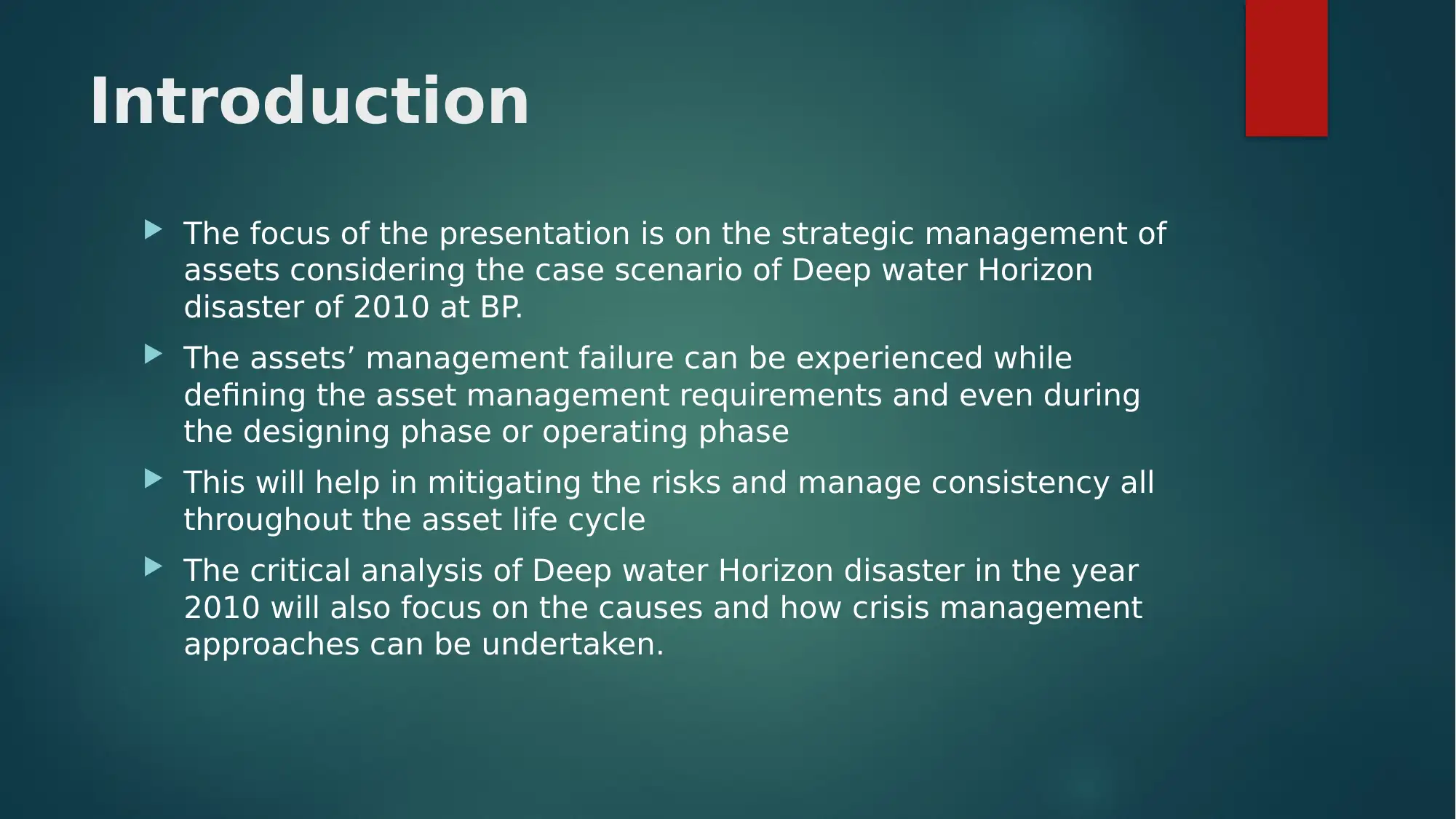
Introduction
The focus of the presentation is on the strategic management of
assets considering the case scenario of Deep water Horizon
disaster of 2010 at BP.
The assets’ management failure can be experienced while
defining the asset management requirements and even during
the designing phase or operating phase
This will help in mitigating the risks and manage consistency all
throughout the asset life cycle
The critical analysis of Deep water Horizon disaster in the year
2010 will also focus on the causes and how crisis management
approaches can be undertaken.
The focus of the presentation is on the strategic management of
assets considering the case scenario of Deep water Horizon
disaster of 2010 at BP.
The assets’ management failure can be experienced while
defining the asset management requirements and even during
the designing phase or operating phase
This will help in mitigating the risks and manage consistency all
throughout the asset life cycle
The critical analysis of Deep water Horizon disaster in the year
2010 will also focus on the causes and how crisis management
approaches can be undertaken.
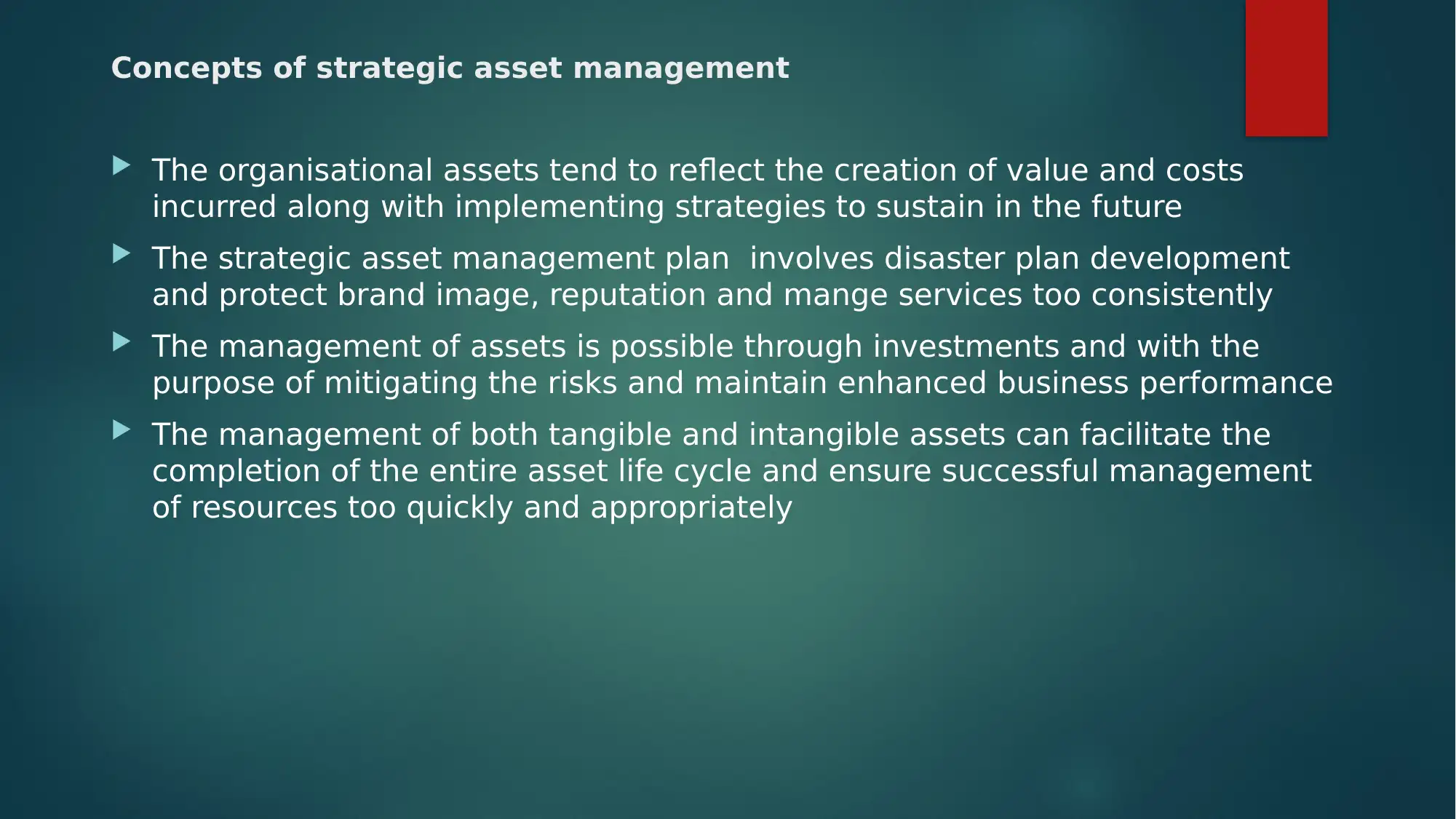
Concepts of strategic asset management
The organisational assets tend to reflect the creation of value and costs
incurred along with implementing strategies to sustain in the future
The strategic asset management plan involves disaster plan development
and protect brand image, reputation and mange services too consistently
The management of assets is possible through investments and with the
purpose of mitigating the risks and maintain enhanced business performance
The management of both tangible and intangible assets can facilitate the
completion of the entire asset life cycle and ensure successful management
of resources too quickly and appropriately
The organisational assets tend to reflect the creation of value and costs
incurred along with implementing strategies to sustain in the future
The strategic asset management plan involves disaster plan development
and protect brand image, reputation and mange services too consistently
The management of assets is possible through investments and with the
purpose of mitigating the risks and maintain enhanced business performance
The management of both tangible and intangible assets can facilitate the
completion of the entire asset life cycle and ensure successful management
of resources too quickly and appropriately
⊘ This is a preview!⊘
Do you want full access?
Subscribe today to unlock all pages.

Trusted by 1+ million students worldwide
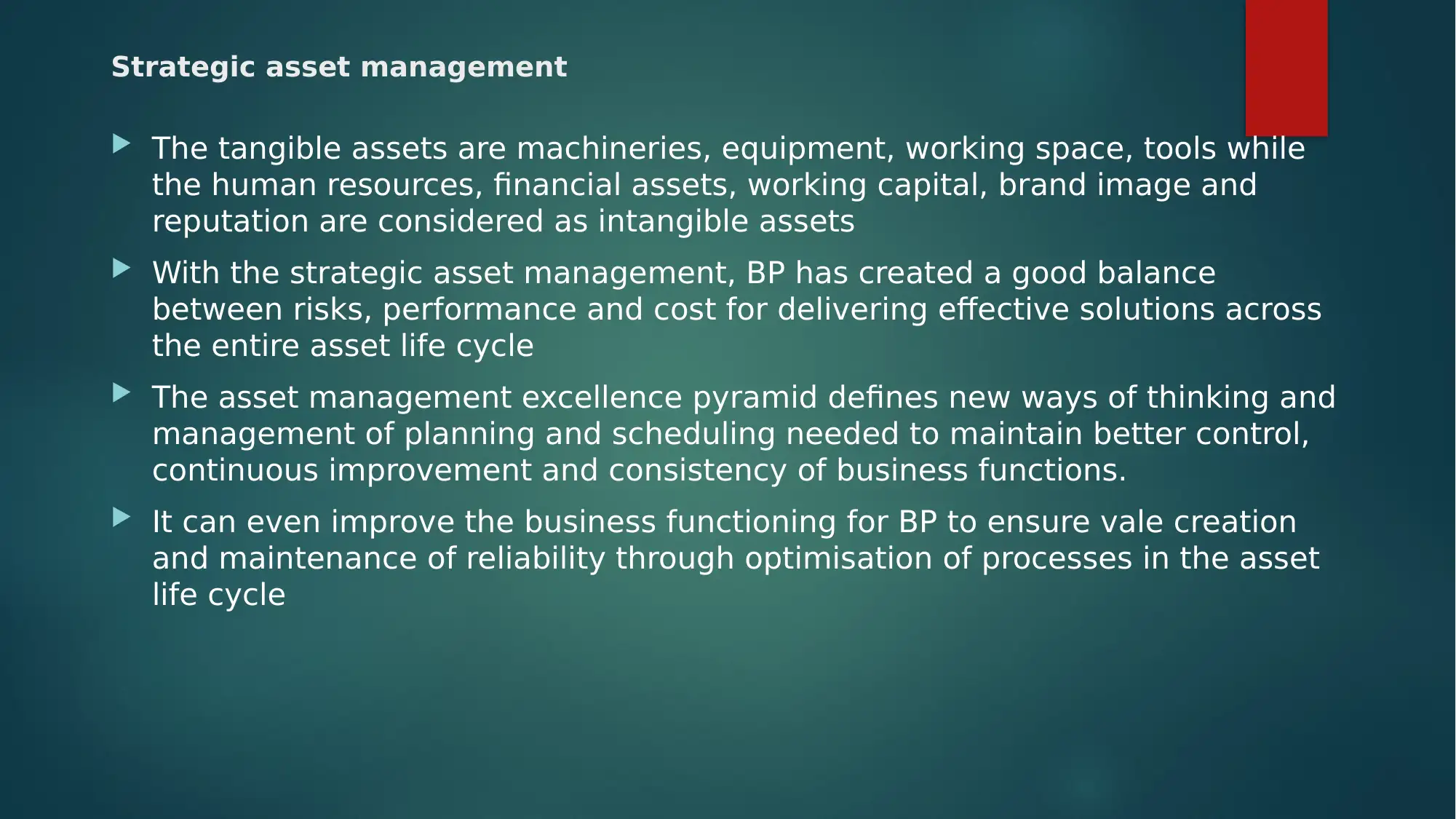
Strategic asset management
The tangible assets are machineries, equipment, working space, tools while
the human resources, financial assets, working capital, brand image and
reputation are considered as intangible assets
With the strategic asset management, BP has created a good balance
between risks, performance and cost for delivering effective solutions across
the entire asset life cycle
The asset management excellence pyramid defines new ways of thinking and
management of planning and scheduling needed to maintain better control,
continuous improvement and consistency of business functions.
It can even improve the business functioning for BP to ensure vale creation
and maintenance of reliability through optimisation of processes in the asset
life cycle
The tangible assets are machineries, equipment, working space, tools while
the human resources, financial assets, working capital, brand image and
reputation are considered as intangible assets
With the strategic asset management, BP has created a good balance
between risks, performance and cost for delivering effective solutions across
the entire asset life cycle
The asset management excellence pyramid defines new ways of thinking and
management of planning and scheduling needed to maintain better control,
continuous improvement and consistency of business functions.
It can even improve the business functioning for BP to ensure vale creation
and maintenance of reliability through optimisation of processes in the asset
life cycle
Paraphrase This Document
Need a fresh take? Get an instant paraphrase of this document with our AI Paraphraser
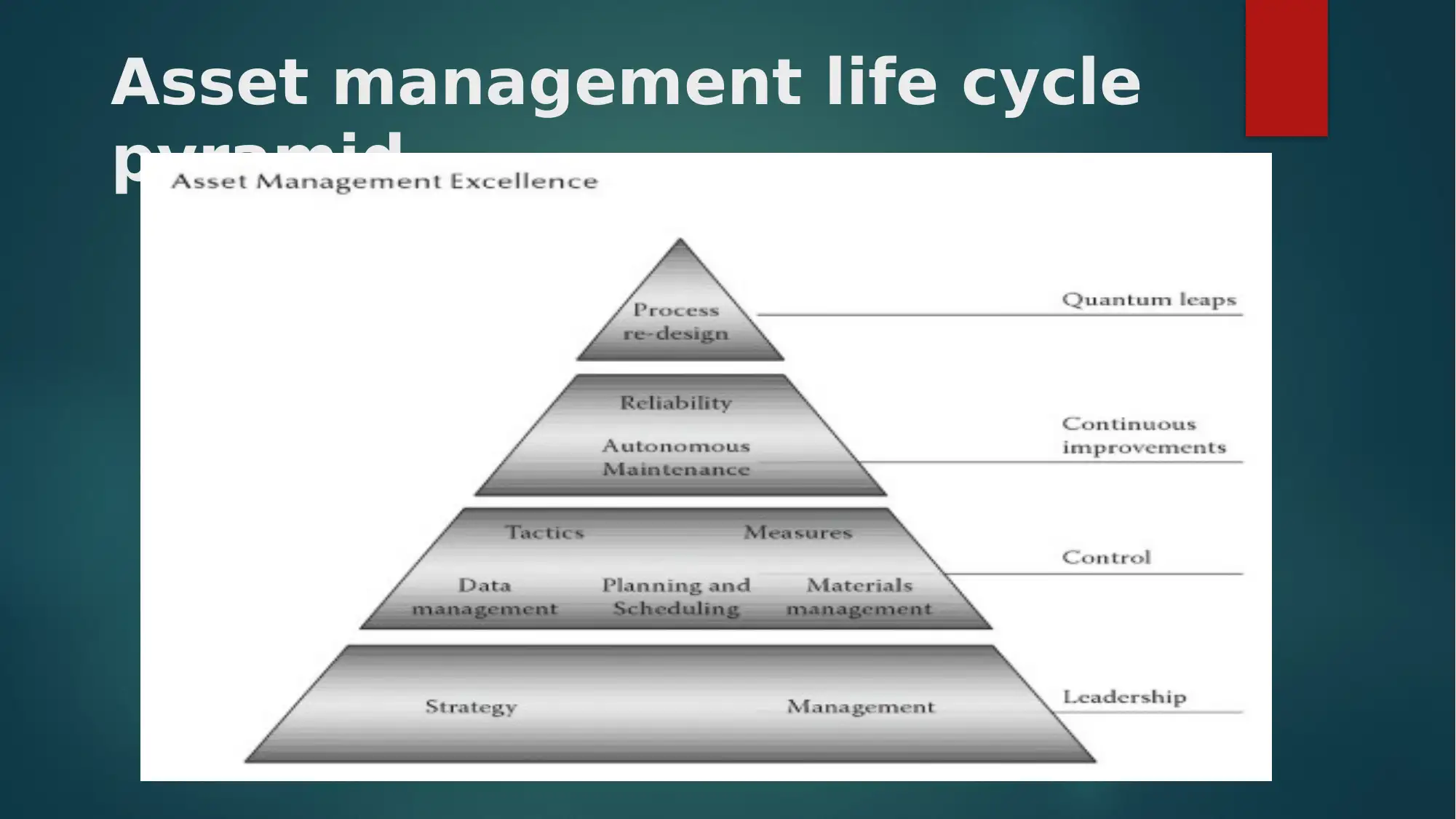
Asset management life cycle
pyramid
pyramid
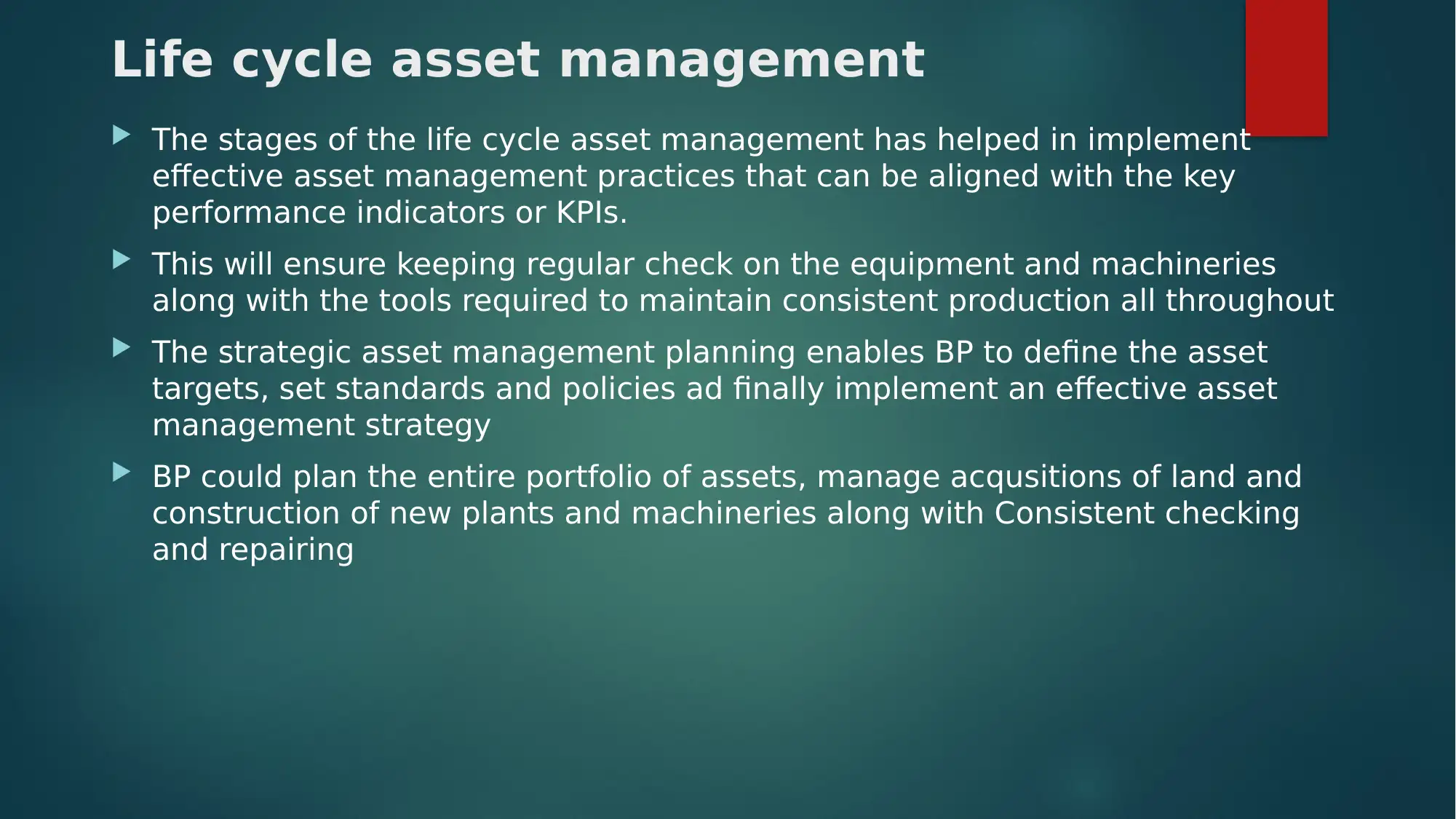
Life cycle asset management
The stages of the life cycle asset management has helped in implement
effective asset management practices that can be aligned with the key
performance indicators or KPIs.
This will ensure keeping regular check on the equipment and machineries
along with the tools required to maintain consistent production all throughout
The strategic asset management planning enables BP to define the asset
targets, set standards and policies ad finally implement an effective asset
management strategy
BP could plan the entire portfolio of assets, manage acqusitions of land and
construction of new plants and machineries along with Consistent checking
and repairing
The stages of the life cycle asset management has helped in implement
effective asset management practices that can be aligned with the key
performance indicators or KPIs.
This will ensure keeping regular check on the equipment and machineries
along with the tools required to maintain consistent production all throughout
The strategic asset management planning enables BP to define the asset
targets, set standards and policies ad finally implement an effective asset
management strategy
BP could plan the entire portfolio of assets, manage acqusitions of land and
construction of new plants and machineries along with Consistent checking
and repairing
⊘ This is a preview!⊘
Do you want full access?
Subscribe today to unlock all pages.

Trusted by 1+ million students worldwide
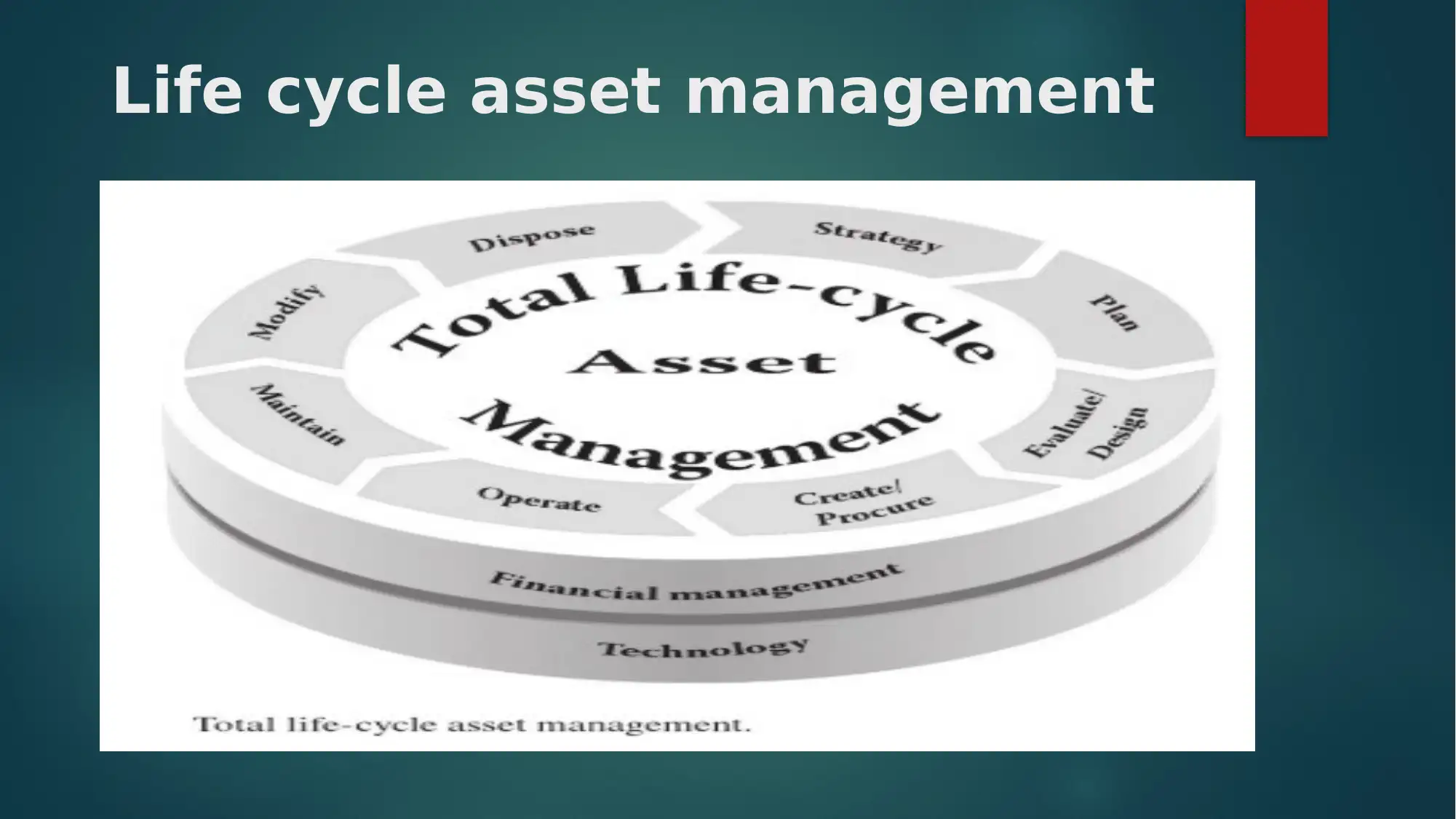
Life cycle asset management
Paraphrase This Document
Need a fresh take? Get an instant paraphrase of this document with our AI Paraphraser
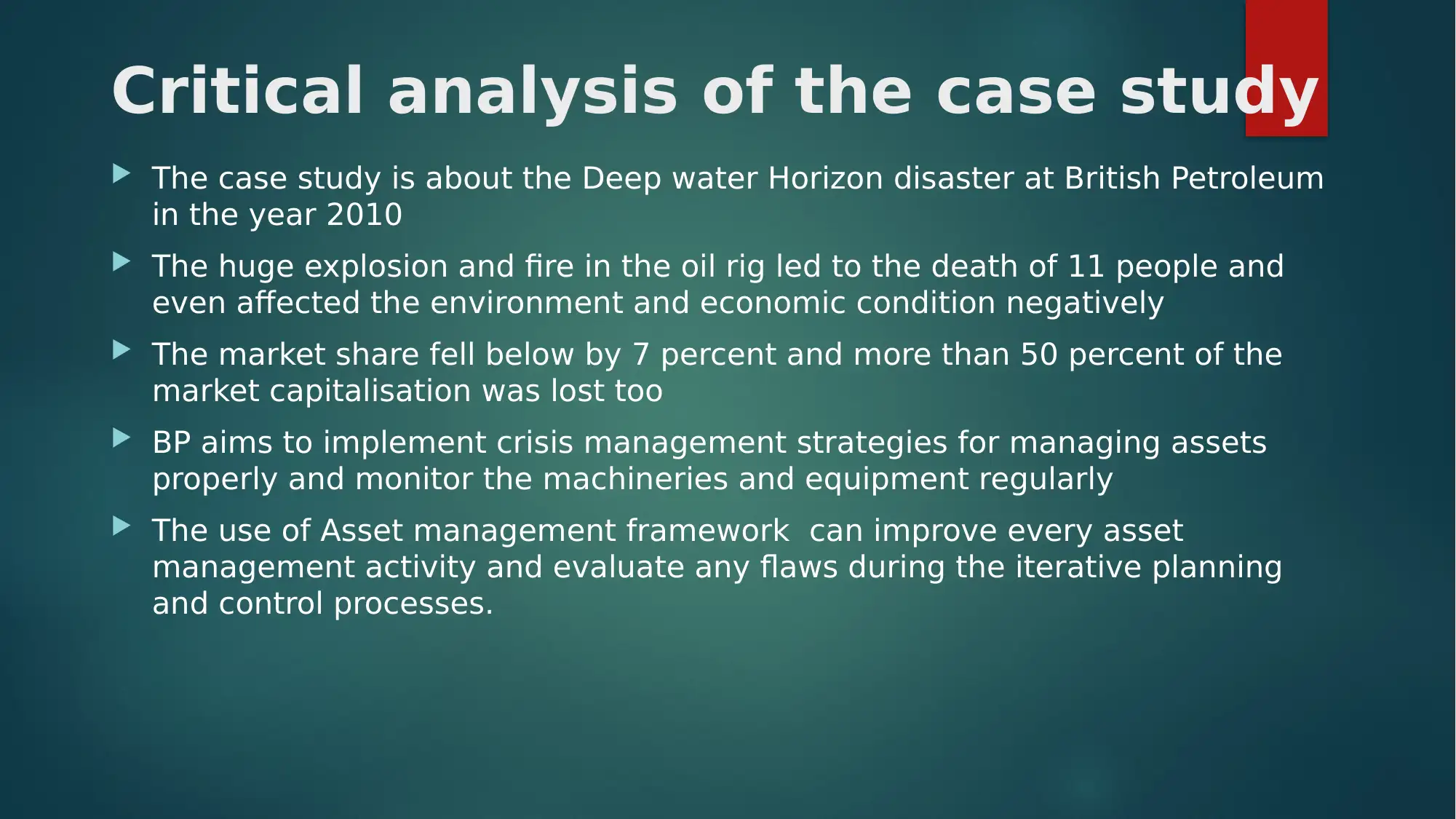
Critical analysis of the case study
The case study is about the Deep water Horizon disaster at British Petroleum
in the year 2010
The huge explosion and fire in the oil rig led to the death of 11 people and
even affected the environment and economic condition negatively
The market share fell below by 7 percent and more than 50 percent of the
market capitalisation was lost too
BP aims to implement crisis management strategies for managing assets
properly and monitor the machineries and equipment regularly
The use of Asset management framework can improve every asset
management activity and evaluate any flaws during the iterative planning
and control processes.
The case study is about the Deep water Horizon disaster at British Petroleum
in the year 2010
The huge explosion and fire in the oil rig led to the death of 11 people and
even affected the environment and economic condition negatively
The market share fell below by 7 percent and more than 50 percent of the
market capitalisation was lost too
BP aims to implement crisis management strategies for managing assets
properly and monitor the machineries and equipment regularly
The use of Asset management framework can improve every asset
management activity and evaluate any flaws during the iterative planning
and control processes.
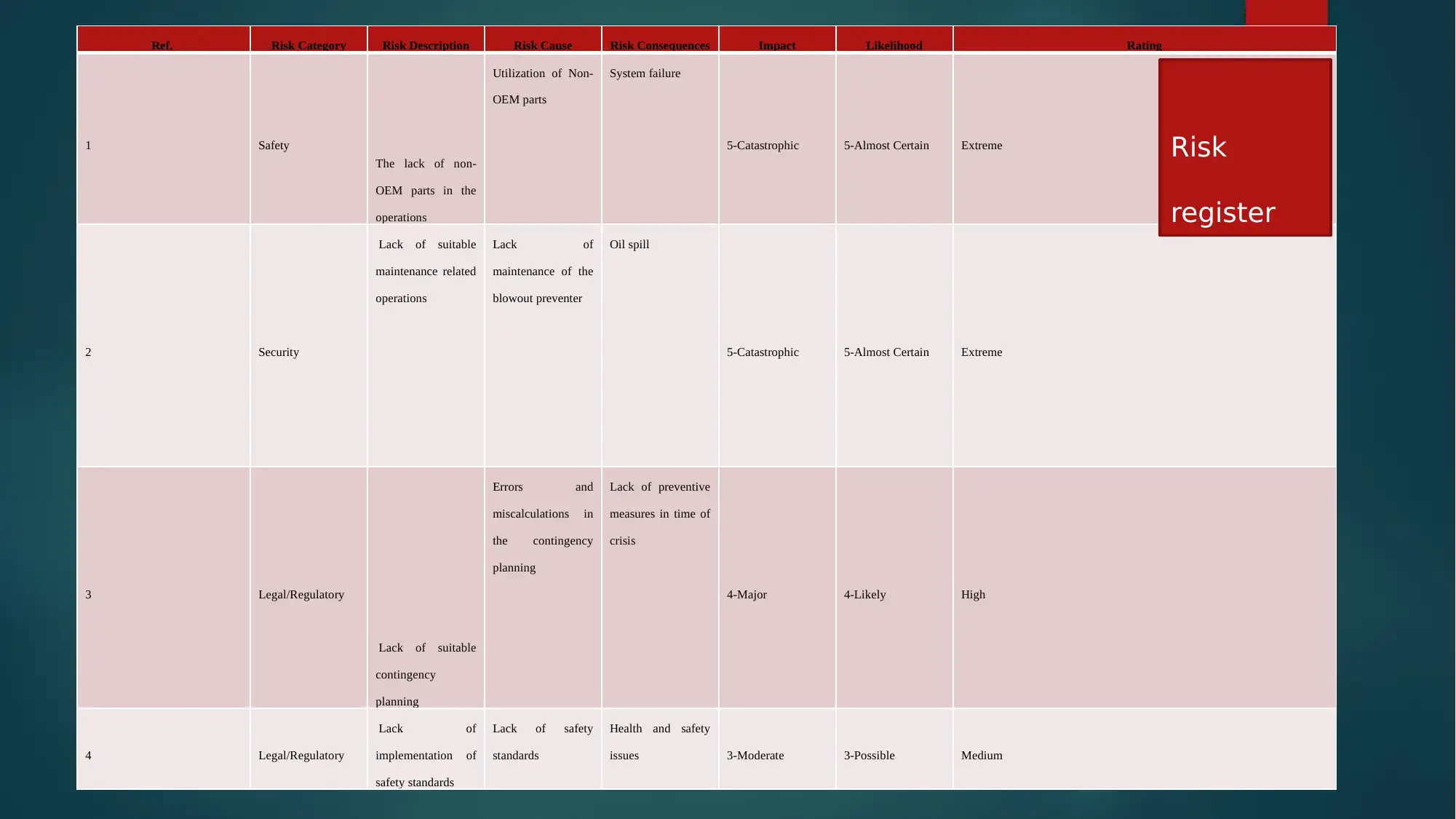
Risk register
Ref. Risk Category Risk Description Risk Cause Risk Consequences Impact Likelihood Rating
1 Safety
The lack of non-
OEM parts in the
operations
Utilization of Non-
OEM parts
System failure
5-Catastrophic 5-Almost Certain Extreme
2 Security
Lack of suitable
maintenance related
operations
Lack of
maintenance of the
blowout preventer
Oil spill
5-Catastrophic 5-Almost Certain Extreme
3 Legal/Regulatory
Lack of suitable
contingency
planning
Errors and
miscalculations in
the contingency
planning
Lack of preventive
measures in time of
crisis
4-Major 4-Likely High
4 Legal/Regulatory
Lack of
implementation of
safety standards
Lack of safety
standards
Health and safety
issues 3-Moderate 3-Possible Medium
Risk
register
Ref. Risk Category Risk Description Risk Cause Risk Consequences Impact Likelihood Rating
1 Safety
The lack of non-
OEM parts in the
operations
Utilization of Non-
OEM parts
System failure
5-Catastrophic 5-Almost Certain Extreme
2 Security
Lack of suitable
maintenance related
operations
Lack of
maintenance of the
blowout preventer
Oil spill
5-Catastrophic 5-Almost Certain Extreme
3 Legal/Regulatory
Lack of suitable
contingency
planning
Errors and
miscalculations in
the contingency
planning
Lack of preventive
measures in time of
crisis
4-Major 4-Likely High
4 Legal/Regulatory
Lack of
implementation of
safety standards
Lack of safety
standards
Health and safety
issues 3-Moderate 3-Possible Medium
Risk
register
⊘ This is a preview!⊘
Do you want full access?
Subscribe today to unlock all pages.

Trusted by 1+ million students worldwide
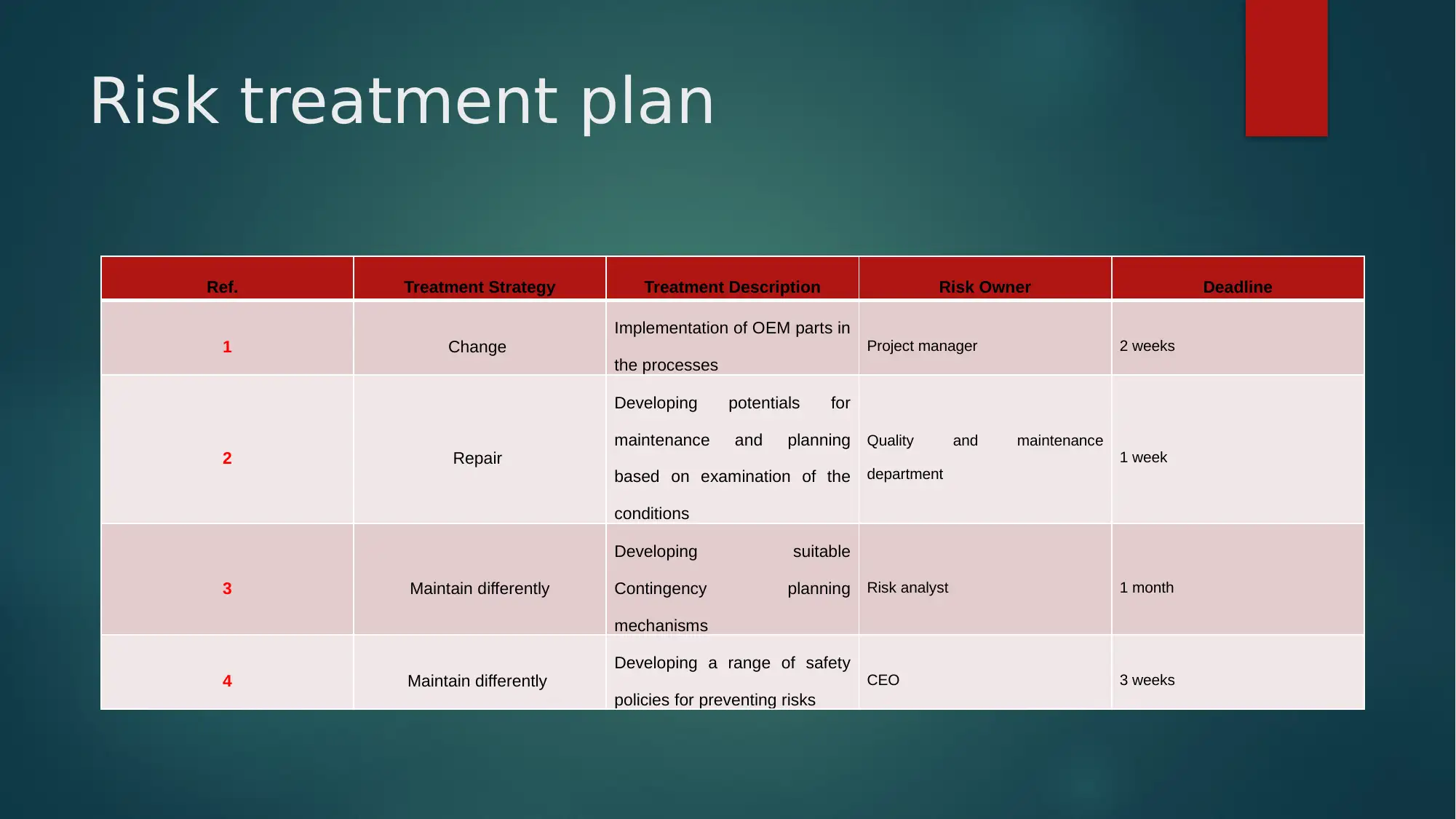
Risk treatment plan
Ref. Treatment Strategy Treatment Description Risk Owner Deadline
1 Change
Implementation of OEM parts in
the processes
Project manager 2 weeks
2 Repair
Developing potentials for
maintenance and planning
based on examination of the
conditions
Quality and maintenance
department
1 week
3 Maintain differently
Developing suitable
Contingency planning
mechanisms
Risk analyst 1 month
4 Maintain differently
Developing a range of safety
policies for preventing risks
CEO 3 weeks
Ref. Treatment Strategy Treatment Description Risk Owner Deadline
1 Change
Implementation of OEM parts in
the processes
Project manager 2 weeks
2 Repair
Developing potentials for
maintenance and planning
based on examination of the
conditions
Quality and maintenance
department
1 week
3 Maintain differently
Developing suitable
Contingency planning
mechanisms
Risk analyst 1 month
4 Maintain differently
Developing a range of safety
policies for preventing risks
CEO 3 weeks
Paraphrase This Document
Need a fresh take? Get an instant paraphrase of this document with our AI Paraphraser
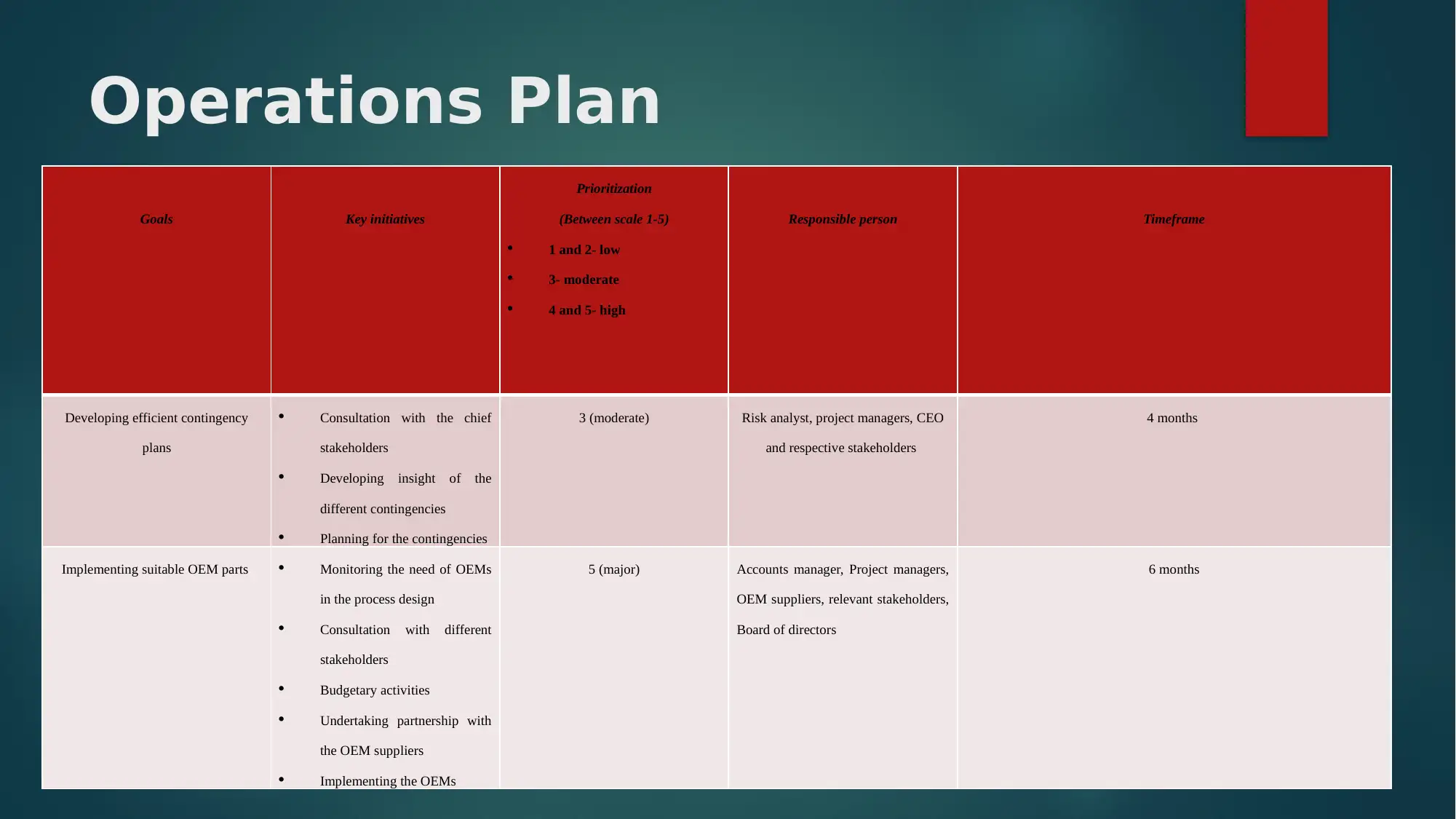
Operations Plan
Goals Key initiatives
Prioritization
(Between scale 1-5)
1 and 2- low
3- moderate
4 and 5- high
Responsible person Timeframe
Developing efficient contingency
plans
Consultation with the chief
stakeholders
Developing insight of the
different contingencies
Planning for the contingencies
3 (moderate) Risk analyst, project managers, CEO
and respective stakeholders
4 months
Implementing suitable OEM parts Monitoring the need of OEMs
in the process design
Consultation with different
stakeholders
Budgetary activities
Undertaking partnership with
the OEM suppliers
Implementing the OEMs
5 (major) Accounts manager, Project managers,
OEM suppliers, relevant stakeholders,
Board of directors
6 months
Goals Key initiatives
Prioritization
(Between scale 1-5)
1 and 2- low
3- moderate
4 and 5- high
Responsible person Timeframe
Developing efficient contingency
plans
Consultation with the chief
stakeholders
Developing insight of the
different contingencies
Planning for the contingencies
3 (moderate) Risk analyst, project managers, CEO
and respective stakeholders
4 months
Implementing suitable OEM parts Monitoring the need of OEMs
in the process design
Consultation with different
stakeholders
Budgetary activities
Undertaking partnership with
the OEM suppliers
Implementing the OEMs
5 (major) Accounts manager, Project managers,
OEM suppliers, relevant stakeholders,
Board of directors
6 months

Operations Plan
Goals Key initiatives
Prioritization
(Between scale 1-5)
1 and 2- low
3- moderate
4 and 5- high
Responsible person Timeframe
Developing a culture of continuous
monitoring and maintenance of the assets
Consultation with the stakeholders
Developing insight on the needs of
asset monitoring and maintenance
Collaborating with asset
maintenance and management
companies
Developing monitoring and
controlling activities
4 (major) Maintenance companies, project managers,
other stakeholders
6 months
Goals Key initiatives
Prioritization
(Between scale 1-5)
1 and 2- low
3- moderate
4 and 5- high
Responsible person Timeframe
Developing a culture of continuous
monitoring and maintenance of the assets
Consultation with the stakeholders
Developing insight on the needs of
asset monitoring and maintenance
Collaborating with asset
maintenance and management
companies
Developing monitoring and
controlling activities
4 (major) Maintenance companies, project managers,
other stakeholders
6 months
⊘ This is a preview!⊘
Do you want full access?
Subscribe today to unlock all pages.

Trusted by 1+ million students worldwide
1 out of 19
Related Documents
Your All-in-One AI-Powered Toolkit for Academic Success.
+13062052269
info@desklib.com
Available 24*7 on WhatsApp / Email
![[object Object]](/_next/static/media/star-bottom.7253800d.svg)
Unlock your academic potential
Copyright © 2020–2025 A2Z Services. All Rights Reserved. Developed and managed by ZUCOL.



